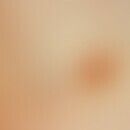Synonym(s)
papular xanthoma
HistoryThis section has been translated automatically.
Winkelmann, 1981
DefinitionThis section has been translated automatically.
Very rare, quite predominantly acquired, normolipemic, cutaneous non-Langerhans cell histiocytosis without any systemic involvement
You might also be interested in
EtiopathogenesisThis section has been translated automatically.
S.u. Non-Langerhans cell histiocytosis. Association with angiokeratoma fordyce has been described.
ManifestationThis section has been translated automatically.
Men are affected about 4 times more often than women.
LocalizationThis section has been translated automatically.
Trunk, extremities, more rarely face (nose region).
ClinicThis section has been translated automatically.
Mostly solitary 0.1-1.2 cm large, rarely occurring in plural, red to red-brown, firm, asymptomatic papules with a smooth, shiny surface. As far as the sparse data available so far allow this statement, three forms of progression are distinguished:
- Self-healing form
- Persistent form
- Progressive form (identical with progressive nodular histiocytosis?).
HistologyThis section has been translated automatically.
Dense, dermal, non-epidermotropic infiltrate under a regular epidermis with numerous xanthomatized macrophages (foam cells) mixed with numerous multinucleated giant Touton-type cells.
Immunohistology: Histiocytes pos. for KiM1p, neg. for factor VIII, S100 and CD1a.
Differential diagnosisThis section has been translated automatically.
LiteratureThis section has been translated automatically.
- Breier F et al (2002) Papular xanthoma: a clinicopathological study of 10 cases. J cutan Pathol 29: 200-206
- Caputo R et al (2003) Papular xanthoma associated with angiokeratoma of Fordyce; considerations on the nosography of this rare non-Langerhans cell histiocytoxanthomatosis. Dermatology 206: 165-168
- Winkelmann RK (1981) Cutaneous syndromes of non-X-histiocytosis. A review of the macrophage-histiocytic disease of the skin. Arch Dermatol 117: 667-672
Outgoing links (6)
Clear cell lacanthoma; Dermatofibroma; Histiocytoses non-langerhans cell histiocytoses; Nevus spitz; Progressive nodular histiocytosis; Scrotal and vulval angiosclerosis;Disclaimer
Please ask your physician for a reliable diagnosis. This website is only meant as a reference.




